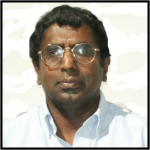Gayanath W Fernando
Professor
Physics
CV: https://physics.media.uconn.edu/wp-content/uploads/sites/2234/2025/03/GWF_CV_25-.pdf
Research Interests
Understanding properties of materials using fundamental principles of quantum mechanics has played a key role in the technological advances that have transformed the living standards of the human race. One important example is the transistor, discovered in 1947 at Bell labs, that is a vital building block of modern electronics and integrated circuits used in computers, televisions and mobile phones. More recently, new magnetic materials, high temperature superconductors and nanomaterials have found important applications in medical and other sciences. Without basic research in condensed matter physics, none of the above advances would have been possible.
Have been engaged in first principles and other (both formal and computational) approaches to electronic, magnetic and structural properties of condensed matter systems for several decades. Some of this early work has appeared in a book on “Metallic Multilayers and their Applications” authored by me and published by Elsevier in 2008. My current research interests include materials with strongly correlated electrons, exact calculations of correlated nanoclusters, high temperature superconductivity, magnetism, topological materials and various symmetry breaking mechanisms in condensed matter systems including quasi two-dimensional organic materials.
Currently working on floquet systems, organic materials,
perovskites and double-perovskites.
Previous work on exact many body calculations of Hubbard nanoclusters
has uncovered numerous exotic properties of strongly correlated clusters
that have not been seen before. Combining exact diagonalization with
statistical mechanics has paved the way to a better understanding
of phase diagrams, pseudogaps, magnetism and condensation (among other things) of
some of the inhomogeneous materials such as the high temperature superconductors
and materials exhibiting colossal magnetoresistance.
Have also initiated work on a book focused on “Time Dependent Single and Many Electron Systems” to be published by World Scientific.
Recent publications:
A Brief Review of Electronic and Magnetic Structure of TIF3,
https://doi.org/10.1142/S012915642440072X: Vol. 33, No. 02n03, 2440072 (2024), International Journal of High Speed Electronics and Systems,
Gayanath W. Fernando, Donal Sheets, Jason Hancock, Arthur Ernst, R. Matthias Geilhfue
Correlation Driven Magnetic Frustration and Insulating Behavior of
TiF3, Gayanath W. Fernando, Donal Sheets, Jason Hancock,
Arthur Ernst, and R. Matthias Geilhufe,
arXiv:2310.1264v1 (2023) and
Physica Status Solidi (Rapid Research Letters), 2300330 (2023).
Mott insulating negative thermal expansion perovskite TiF3,
Donal Sheets, Kaitlin Lyszak, Menka Jain, Gayanath W. Fernando, Ilya Sochnikov, Jacob Franklin, R. Mattias Geilhufe, Jason N. Hancock,
arXiv:2311.08382 and Physical Review B 108, 235140 (2023).
The Quantumness in Detecting
Electromagnetic Waves is Determined by
the Interaction Properties of the Detector,
C. Roychoudhuri, N. Prasad and G. Fernando,
Fundamental Research and Application of Physical Science Vol. 3,
B P International, Print ISBN: 978-81-19217-29-8, eBook ISBN: 978-81-19217-05-2
(2023),
Structural and electronic properties of rare-earth chromites: A computational and experimental study,
Jianhang Shi, Gayanath W. Fernando, Yanliu Dang, Steven L. Suib and Menka Jain (Phys. Rev. B106, 165117, 2022).
Understanding physical processes behind the photoelectric current pulse (PCP) statistics and designing better sources, C. Roychoudhuri, G. Fernando, and N. Prasad, Proc. SPIE 12243, Photonics for Quantum 2022, 1224303 (19 July 2022).
Driven emergent phases in small interacting condensed-matter systems, Gayanath W. Fernando, R. Matthias Geilhufe, Adil-Gerai Kussow and W. Wasanthi P. De Silva: , , 37004 (2021): https://iopscience.iop.org/article/10.1209/0295-5075/134/37004
Chemical-strain induced tilted Dirac nodes in (BEDT-TTF)2 X3 (X=I, Cl, Br, F) based charge transfer salts, R. M. Geilhufe, B. Commeau and G. W Fernando, Physica Status Solidi, 1800081 (2018).
Structural and electronic properties of alpha-(BEDT-TTF)2I3,
beta-(BEDT-TTF)2I3 and
kappa-(BEDT-TTF)2X3 (X=I, F, Br, Cl) organic
charge transfer salts,
B. Commeau, R. M. Geilhufe, G. W. Fernando, A. V. Balatsky,
Physical Review B 96, 125135 (2017).
Education
- Ph.D., Physics, Cornell University, 1985
- M.S., Physics, Cornell University, 1982
- B.S., Mathematics, University of Colombo, Sri Lanka, 1978
Work Experience
- 1991-present: Professor, Department of Physics, University of Connecticut
- 1987-1991: Scientist, Department of Physics, Brookhaven National Laboratory
- 1984-1986: Postdoctoral Fellow, Department of Physics, West Virginia University

| gayanath.fernando@uconn.edu | |
| Phone | (860)486-0442 |
| Fax | (860)486-3346 |
| Mailing Address | Dept. of Physics, University of Connecticut unit 3046, 196 Auditorium Road, Storrs, CT 06269-3046 |
| Office Location | S213D |
| Campus | Storrs |
| Link | http://www.phys.uconn.edu/~fernando/ |